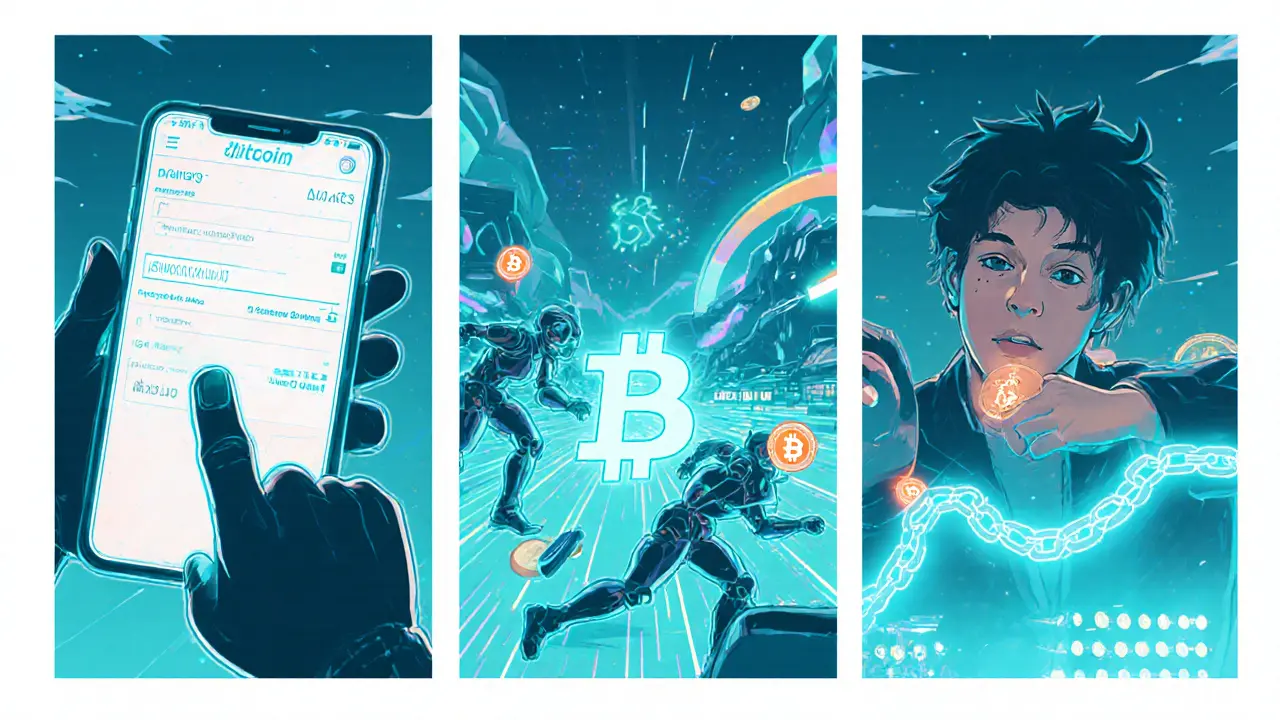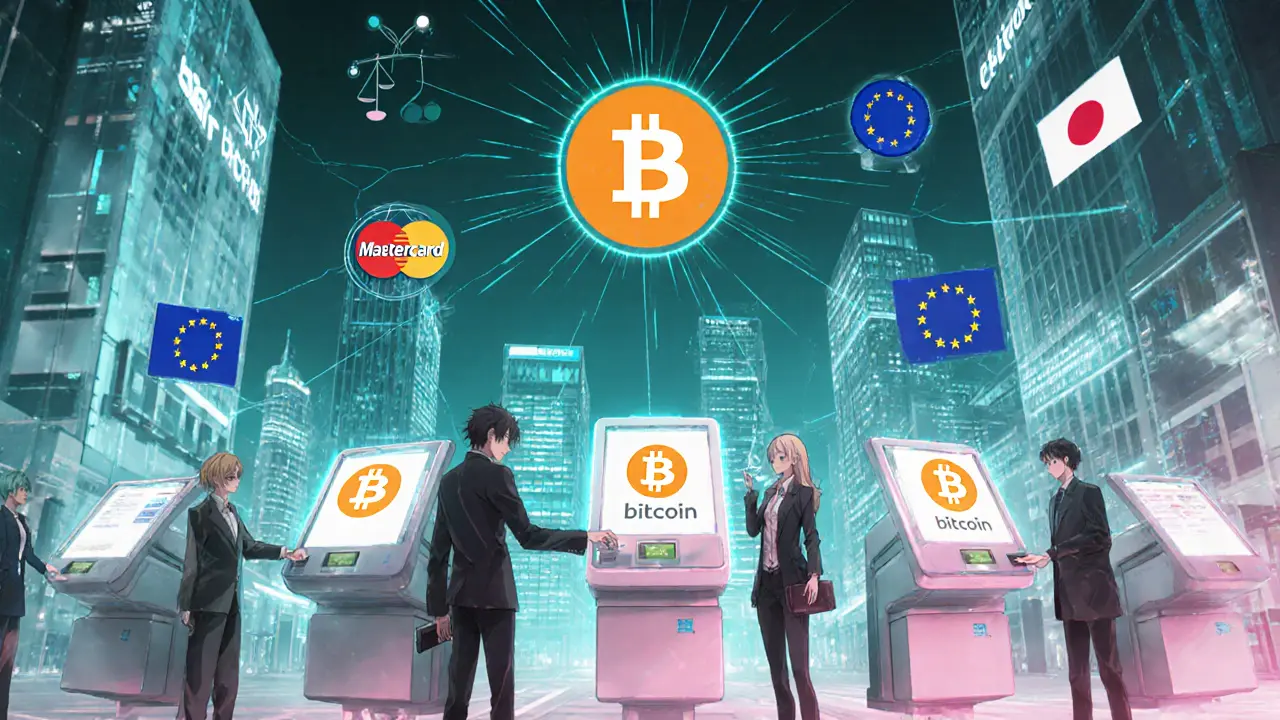Bitcoin Transaction Fee Estimator
Estimate Your Bitcoin Transaction Cost and Time
Enter your desired fee level to estimate transaction costs and confirmation times.
Estimated Transaction Details
When people talk about Bitcoin a decentralized digital cryptocurrency created by the pseudonymous Satoshi Nakamoto, they often wonder if it can serve as a real‑world Bitcoin payment method.
- Bitcoin can move money across borders without a bank.
- Transactions settle on a public Blockchain a distributed ledger that records every Bitcoin transfer.
- Fees and speed vary with network congestion.
- Institutional products like spot Bitcoin ETPs make exposure easier.
- Regulatory clarity is improving, but volatility remains a hurdle.
What makes Bitcoin a candidate for digital payments?
Bitcoin was designed as “electronic cash” - a peer‑to‑peer system where anyone can send value without a central authority. The core engine is the Blockchain a chain of cryptographically linked blocks that store every transaction ever made. Each block is validated by a global network of nodes, ensuring trust without a bank. Because the supply caps at 21million coins and new units are released by a predictable algorithm, Bitcoin’s value comes from market demand rather than a government decree.
How a Bitcoin transaction works
- Buy Bitcoin on an exchange or from another user.
- Move the coins to a Crypto wallet software or hardware that stores private keys and generates public addresses.
- Enter the recipient’s address and the amount you want to send.
- Choose a transaction fee - higher fees speed up confirmation because miners prioritize lucrative jobs.
- Sign the transaction with your private key; the network broadcasts it to peers.
- Miners bundle the transaction into a block; once the block is added to the chain, the recipient sees the funds.
Depending on network load, confirmation can take from a few minutes (with a high fee) to several hours (with a low fee). Unlike credit cards, there’s no chargeback mechanism, which some merchants see as a security upside.
Benefits and challenges compared to traditional payment methods
| Aspect | Bitcoin | Credit Card | Bank Transfer |
|---|---|---|---|
| Settlement time | Minutes‑to‑hours (fee‑dependent) | Instant (online) - up to 2days (batch) | 1‑3days (international) |
| Average fee (2025) | $1‑$15 per transaction (network‑based) | 1.5‑3% of purchase | $0‑$30 (wire fee) |
| Chargeback risk | None - irreversible | High - disputes common | Low - bank mediation |
| Global acceptance | Growing, but still niche | Universal for fiat | Universal for fiat |
| Volatility impact | High - price can swing >10% daily | Stable (fiat) | Stable (fiat) |
The table shows why Bitcoin shines for cross‑border, low‑intermediary payments, but its price swings make it less attractive for everyday retail purchases.

Institutional infrastructure that’s easing Bitcoin payments
Since the U.S. Securities and Exchange Commission (SEC) the federal agency that regulates securities markets approved spot Bitcoin Exchange‑Traded Product (ETP) a regulated fund that holds physical Bitcoin and trades on exchanges in early 2024, investors gained a familiar, custodial way to hold Bitcoin. Major banks now offer custodial wallets, reducing the technical burden for corporate clients.
Payment networks are also stepping in. Mastercard Multi‑Token Network a platform that tokenizes digital assets for secure, scalable transactions completed a live test with Standard Chartered Bank, proving that banks can settle Bitcoin‑linked payments almost as quickly as fiat transfers. J.P.Morgan’s Kinexys project is another example of a traditional institution building the plumbing needed for mass‑market crypto payments.
Real‑world adoption: merchants, users, and obstacles
Retailers that accepted Bitcoin early - such as a handful of online fashion stores and tech shops - reported mixed results. On the upside, they enjoyed borderless sales and lower fraud rates. On the downside, customers complained about waiting for confirmations and seeing the price shift beneath them while the transaction was pending.
To smooth the experience, many merchants now rely on payment processors that automatically convert incoming Bitcoin to local fiat at the moment of sale. This eliminates volatility for the seller but re‑introduces a third party, which some crypto purists dislike.
For everyday users, the biggest hurdles remain:
- Understanding private keys and backup strategies.
- Choosing a wallet that balances security and usability.
- Estimating transaction fees during periods of network congestion.
Community forums on Reddit and Discord provide step‑by‑step guides, while regulated brokerages now bundle Bitcoin exposure with familiar login flows, lowering the entry barrier for non‑technical consumers.
Future outlook: regulation, CBDCs, and wider acceptance
Governments are catching up. The European Union’s Markets in Crypto‑Assets (MiCA) regime, effective from the end of 2024, gives clear licensing rules for crypto service providers, which should boost consumer confidence in Bitcoin‑related services across Europe.
Central banks are also launching digital currencies - the European Central Bank expects a full‑fledged euro digital currency by 2025, and China’s e‑yuan is already in pilot mode. While CBDCs are government‑backed, Bitcoin remains the only truly decentralized digital asset, positioning it as a hedge against potential surveillance or policy‑driven devaluation.
Analysts at Charles Schwab project that institutional Bitcoin exposure could double by 2027, thanks to expanding spot ETPs and growing corporate treasury allocations. If transaction‑layer solutions like the Mastercard Multi‑Token Network achieve mainstream scale, merchants may finally offer near‑instant Bitcoin checkout without worrying about price swings.
Key takeaways
- Bitcoin’s core technology - the Blockchain - guarantees trustless settlement.
- Transaction speed and cost are linked to the fee you pay; higher fees mean quicker confirmation.
- Volatility is the biggest barrier for everyday payments, but institutional products and instant fiat conversion mitigate risk for merchants.
- Regulatory clarity in the U.S., Europe, and Asia is improving, encouraging more businesses to experiment with Bitcoin payments.
- Future adoption hinges on layer‑2 solutions, tokenized networks, and broader consumer education.

Frequently Asked Questions
Can I use Bitcoin to pay for coffee today?
Only a few cafés accept Bitcoin directly, and they usually require a QR‑code scan and a wait of several minutes for confirmation. Most coffee shops that claim to accept Bitcoin actually use a processor that instantly converts the payment to local currency, so the transaction feels like a regular card swipe.
How much does a Bitcoin transaction cost?
Fees fluctuate with network demand. In 2025 the average fee ranged from $1 for low‑priority transfers to $15‑$20 during peak congestion. You can set a custom fee; wallets typically suggest a range based on the desired confirmation time.
Is Bitcoin a safe way to store money?
Security depends on how you store the private keys. Hardware wallets kept offline are considered the safest option. Storing coins on an exchange is convenient but exposes you to hacks and bankruptcy risk.
What’s the difference between a Bitcoin ETF and a spot Bitcoin ETP?
An ETF holds futures contracts or other derivatives, so its price may diverge from Bitcoin’s spot price. A spot Bitcoin ETP, approved by the SEC in 2024, holds actual Bitcoin, giving investors exposure that tracks the market price more closely.
Will future regulations make Bitcoin payments easier?
Regulations like the EU’s MiCA and clearer guidance from the SEC provide a legal framework for custodians and payment processors, which should lower compliance costs and increase consumer confidence, ultimately smoothing the path for broader Bitcoin payment acceptance.


10 Responses
Bitcoin’s promise feels like a modern myth, a digital gold rush that seduces both dreamers and skeptics alike. We’re watching a technology that can move value without borders, yet many still treat it like a novelty. The fee estimator is a neat tool, but it also reminds us how volatile the network can be. In the end, it’s a reminder that power comes with responsibility.
While the mythic allure is tempting, the practical reality is harsher. Transaction fees can erode margins for small merchants, and the confirmation delays feel archaic compared to instant card payments. The article glosses over these pain points, so readers should temper their optimism with a dose of hard data.
Honestly, the whole "Bitcoin as payment" narrative feels like a contrarian hobby project. Most businesses that dabble in it end up adding a fiat conversion layer, which defeats the purpose of decentralization. If the ecosystem truly wanted mainstream adoption, it would focus on making the user experience seamless, not on preaching utopian ideals.
Yo, I get the hype but also the grind. If you’re looking to actually pay for stuff, you need a wallet that’s fast and a fee that won’t break the bank. The estimator is cool, but remember miners prioritize the highest payers – so low‑fee transactions can sit for ages. Think of it like rush‑hour traffic: you either pay the toll or wait.
Wow!!! The fee‑estimator is super helpful-!!! But!!! Remember!!! That the fee you set isn’t static-!!! It fluctuates with network congestion-!!! So always double‑check before you hit send-!!! Otherwise you might end up overpaying!!!
When we contemplate Bitcoin as a genuine payment system, we must first dissect the underlying architecture that both empowers and constrains its utility. The blockchain’s consensus mechanism, proof‑of‑work, is a double‑edged sword: it secures the ledger against tampering, yet introduces latency and energy consumption that traditional payment rails simply do not face. Each block, arriving roughly every ten minutes, acts as a batch processor, meaning that unless a user attaches a competitive fee, their transaction may linger in the mempool for an indeterminate period. This is why fee estimation tools are indispensable; they translate the abstract notion of “network congestion” into concrete monetary values that users can consciously decide upon. Moreover, the irreversibility of Bitcoin transactions eliminates chargeback fraud, a feature that merchants find appealing, but it also shifts the risk entirely onto the consumer in the event of an erroneous transfer. The volatility of Bitcoin’s price compounds this risk, as the value of a transaction can swing dramatically between the moment a payment is initiated and when it finally confirms. To mitigate this, many merchants employ instant fiat conversion services, which, while preserving revenue certainty, re‑introduce trusted intermediaries, thereby eroding the pure decentralization ethos. Regulatory developments, such as the EU’s MiCA framework, aim to provide clearer guidelines for custodians and payment processors, potentially fostering broader adoption by reducing legal uncertainty. Yet, the arrival of central bank digital currencies (CBDCs) presents a competitive challenge: CBDCs will likely offer faster settlement times and direct governmental backing, attributes that could overshadow Bitcoin in everyday commerce. Nonetheless, Bitcoin retains a unique positioning as a hedge against inflationary policies and a store of value that is not subject to sovereign control. The future of its role in payments hinges on layer‑2 solutions like the Lightning Network, which promise near‑instant, low‑fee transactions, thereby addressing both speed and cost concerns that presently limit mass‑market usage. In summary, while Bitcoin’s foundational technology provides unparalleled security and censorship resistance, its practical deployment as a payment method demands careful navigation of fee dynamics, volatility, regulatory landscapes, and complementary scaling technologies.
Keep the optimism alive – Bitcoin can evolve!
Enough sugar‑coating, Bitcoin payments are a logistical nightmare for anyone not willing to become a full‑time miner. The fees are a racket, the confirmation times are a gamble, and the volatility turns every purchase into a gamble. If you’re serious about commerce, stick to proven rails.
Hold up, let’s not dismiss the whole ecosystem just yet. There are already robust custodial solutions that automate fiat conversion, which means merchants can enjoy the security benefits without exposure to price swings. Plus, the community is constantly iterating on user‑friendly wallets that lower the barrier to entry. It’s a matter of perspective, not a black‑and‑white verdict.
Imagine a world where point‑of‑sale terminals whisper the poetry of cryptographic signatures while humming the lullaby of instant settlements. That vision isn’t far‑fetched; it’s nestled within the vibrant tapestry of the Lightning Network, a layer‑2 marvel that stitches together micro‑payments like beads on a string. By channeling funds off‑chain, we escape the sluggish cadence of on‑chain confirmations and sidestep the mercurial fee spikes that currently plague users. Merchants could, in theory, accept a coffee purchase with the same breezy speed they enjoy card swipes today, all while preserving the decentralized spirit that birthed Bitcoin. The key lies in mainstream adoption of user‑centric interfaces that abstract away the underlying complexity, turning cryptographic dance steps into a simple tap. As more developers contribute to seamless wallet integrations and regulatory clarity continues to rise, the once‑remote dream of frictionless crypto commerce inches nearer to reality. So, while skepticism is healthy, let’s also celebrate the relentless innovation that could soon render today’s payment woes a relic of the past.